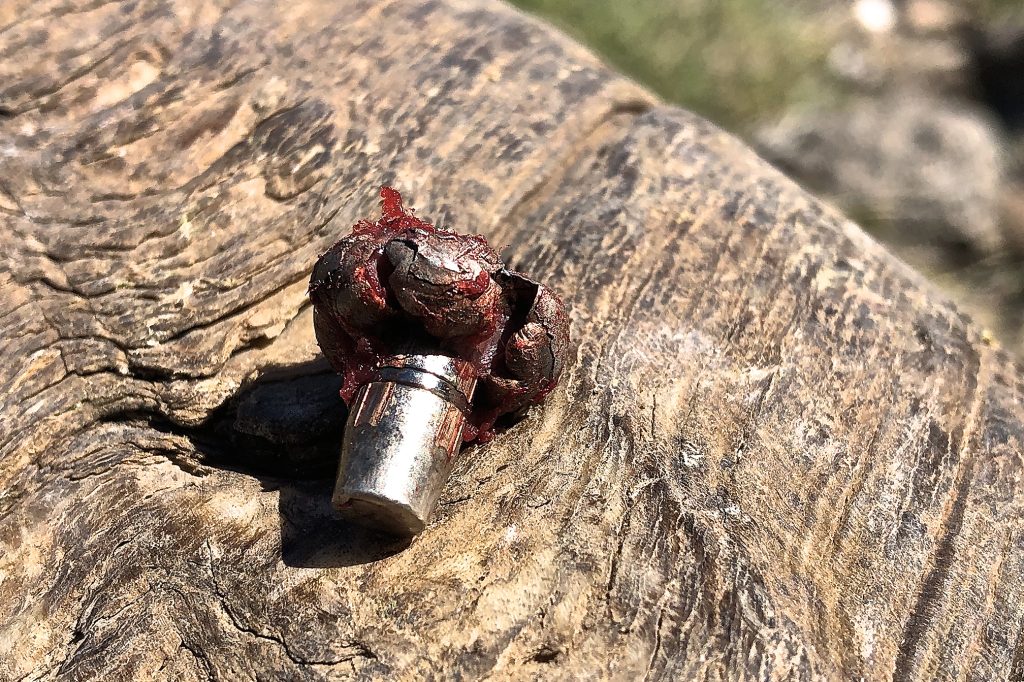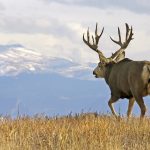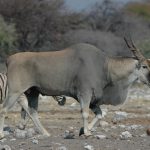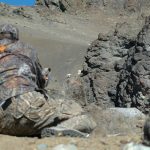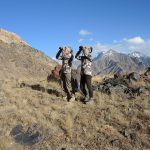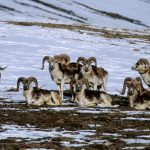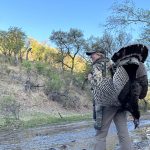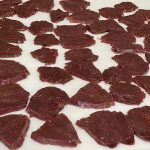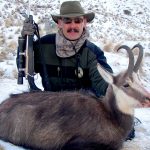Hunting the “poor man’s desert sheep” during an unusually rainy week in West Texas.
West Texas is not usually known for being cold and rainy. Mostly it’s hot. And dry. Shimmering, heat-induced mirages dance across jagged ridges and rocky arroyos, while roadrunners pant in the shade. That’s what West Texas is usually like. But not today–today it’s cold; we huddle against the chill, collars turned up against the damp wind. Fog rolls in and out, making it difficult to see the distant ridges and cliff faces we’re inspecting though our binoculars. We’re searching West Texas for aoudad, the “poor man’s desert sheep,” but it feels more like we’re hunting in the Pacific Northwest. Chilled and damp, we crowd back into our truck to four-wheel to another glassing spot.
Aoudad, also known as Barbary sheep, are native to North Africa. They possess legendary eyesight and no sense of humor whatsoever, rendering them an elusive and challenging quarry to hunt. A mature ram will stand roughly three and a half feet tall at the shoulder and might weigh 300 pounds or better. They are rusty red-gold in color, sporting tough, abrasion-resistant hair. A long, blondish mane grows down the front of their neck and cascades from the fore part of their front legs, forming spectacular chaps on many mature rams. Aoudad are known for toughness, too, requiring a well-constructed bullet and accurate shot placement to achieve a quick, clean kill.
Barbary sheep have been transplanted to multiple locations around the globe over the last century or so. Reportedly first brought to the United States around the year 1900, they were introduced into the wild in New Mexico in 1950 and Texas in 1957. Since, they have flourished across the desert ridges and badlands of both states, in many cases becoming so plentiful that they compete with native wildlife. They typically move in herds and feed indiscriminately, often badly overgrazing sensitive plants and posing a very real threat to local vegetation and habitat. Because of these proclivities, landowners, ranchers, and wildlife biologists are commonly unified in their desire to aggressively manage local aoudad populations. In Texas, Barbary sheep are categorized as an exotic species and therefore huntable 24/7/365. Management practices are determined and implemented by the landowner, often in conjunction with an outfitter who leases the land for the purpose of hunting. Aoudad reproduce prolifically and are talented survivalists, and in most cases they stay well ahead of population objectives.
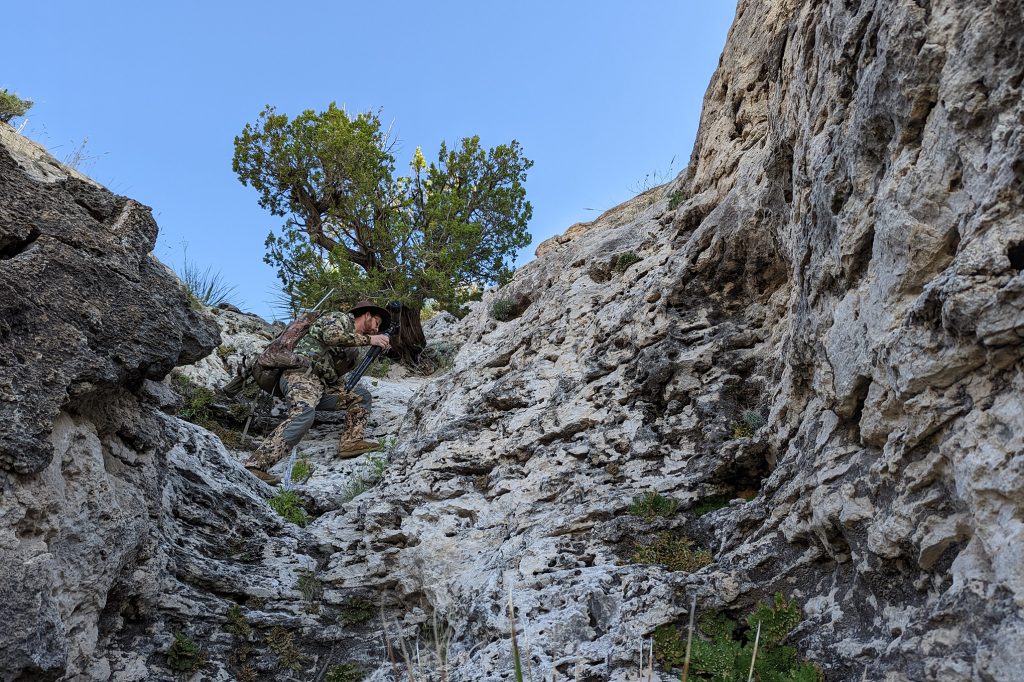
Many hunters, myself included, dream of hunting wild sheep. But for me, and for most blue-collar hunters, a hunt for native wild sheep is financially unattainable. That’s where Barbary sheep enter the scene; a good aoudad hunt will set you back roughly one-tenth or less of the cost of a desert sheep hunt, and in many ways the hunt resembles that of a desert sheep, in similar country and with similar challenges. It’s no wonder hunters have nicknamed aoudad hunting the “poor man’s sheep hunt.”
The Big Bend country of Texas is a long way from anyplace with high rises and traffic lights. Nestled into a northward-curving bend on the Rio Grande River, Big Bend National Park is a place of surreal desert beauty, shimmering heat, and deep, cliff-rimmed canyons. Rattlesnakes continue their age-old quest for packrats, cottontail rabbits, and unwary tourists. Javelinas snuffle about cactus patches, smacking noisily as they chomp down great bites of prickly pear. And sheep live in the cliffs. Desert sheep, but Barbary sheep too, especially north of the park in the vast ranchlands stretching from the badlands across the Permian Basin toward New Mexico. This is where my hunting partner Jake Burns and I are headed, the tires of our rented imitation SUV humming down the lonely West Texas highway as darkness falls. Jake’s flight was delayed and it’s almost midnight when we pull into Alpine, Texas, and stumble into a motel for some much-needed sleep.
Dawn finds our imitation SUV dead alongside a ranch road, having made it all of a quarter mile from the blacktop before blowing a tire. It’s a problem, but nothing unusual in remote ranch country. Jake and one of the guides point the vehicle back toward Alpine for a replacement tire, rolling gingerly along on the rental-company’s donut spare. I climb in with head guide Cross Moody and we continue southward, Cross’s truck grumbling carefully down the rough ranch road. Emptiness stretches for miles, reaching away into the distance to where the desert merges with a lowering, rain-promising sky. It’s a place that makes city folks nervous and anxious with too much freedom. Cowboys, desert rats, and hunters feel like they are coming home, the emptiness promising and hopeful with adventure.
An old, hand-built stone ranch house greets us as we arrive at camp, where pioneer equipment and piles of shed mule deer antlers decorate the surroundings. We unload the truck, stowing gear and a week’s worth of food inside the ranch house. Settled in, we turn our attention to the hills. The sheep await, but first I need to check the zero on my rifle. Airline baggage handlers have a way of making undesirable adjustments to shooting irons, and it’s always wise to conduct a quick test before heading afield.
Belly down on a gravely rise, I adjust my turret and steady my cross hairs on a three-inch-high by six-inch-wide rock, 500 yards distant. My first shot breaks clean and the bullet strikes a fraction of an inch over the rock. A second bullet impacts next to the first, verifying that my scope, mounts, and rifle withstood the best efforts of the baggage handlers. I’m ready to hunt.
That evening we spot a lone ram feeding through the jumbled outcropping of a broken cliff. He disappears over the top, but Cross doesn’t think he is old enough to be worth pursuing. We drive and glass, fighting the fog, searching the uncommonly sodden Chihuahuan desert for elusive aoudad. Just before dark I spot two rams silhouetted against the dusk a half-mile away on a mesa top. One looks particularly good, with heavy, deep-curling horns. We circle for a favorable wind and move in, but darkness overtakes us and we never see them again.
It’s dawn once more, and Jake has rejoined us. I watch Cross’s little brown-and-white Jack Russell shivering in the bed of the Tacoma. It’s partly from the cold but also part excitement; Spade loves to hunt. I worry about him as we drive into the broken desert; he appears about to turn into a brown-and-white hunk of shivering ice. Cross notices and gives me a hard time for allowing Spade to play upon my sympathies. The morning rolls on and so do we, moving and glassing, glassing and moving. Spade plays his cards well and ends up riding inside the truck next to me, eagerly staring out the front window in search of game. I may be a sucker, but we both enjoy the arrangement. The day passes without excitement, and I can feel Cross getting tense at the lack of game. Perhaps it’s the weather that is keeping the sheep hunkered down and out of sight.
Another day dawns like the ones before it, gloomy and damp. I enjoy the moisture–it’s far too rare in the desert to ever resent. But it does make hunting harder, and this day passes much like the previous ones, with a lot of moving, glassing, and moving. The afternoon grows old, and finally Cross spots three sheep far away and below us on the point of a ridge. We study them through our spotting scopes and they are all ewes. We continue on, moving rapidly from vantage to vantage, trying hard to find some rams before darkness falls. Luck eludes us though, and the silence is loud inside the truck as we head for camp. Cross is feeling the pressure and breaks the silence, telling us that he is trying hard to find sheep. I assure him that I know he is, but he doesn’t seem convinced. We only have one day left. Fortunately, the forecast calls for sunshine and calm. It’s the kind of day we’ve been waiting for.
Blue skies greet us at dawn, and as the sun chases the shadows from the desert, we roll carefully along the gravel ranch road toward a section of tall, broken territory. A great cliff illuminates in the morning sunshine, and just above it, Jake spots a band of sheep. It’s a big band, and Cross doesn’t spend more than a few seconds in his spotting scope before uttering the words we’ve been waiting four days to hear: “There’s a couple big rams in that group. Let’s go!”

We tuck the truck out of sight behind a butte, shed some layers, and check the water bottles in our packs. Jake and I ready our rifles and correlate briefly; if a shot opportunity presents itself, I am to take the first shot. Hopefully a second ram will present an opportunity and he will get a chance too. Shouldering our packs, we head across a big alkali swale that’s rimmed by a small ribbon of slickrock opposite us. The breeze is in our faces now, but air is capricious in terrain like this and that could change once we circle the big butte to access the sheep.
The morning is bright now, a brassy sun glaring cheerfully at the desert she hasn’t seen in almost a week. The sky is blue and I feel great as we stop to shed another layer; after days of damp, overcast chill we are dressed too warmly. Moving on, we climb carefully up through a notch in the slickrock cliff. Cross slips ahead to look for the sheep.
The sheep are there, much closer than expected and moving toward us. We belly down on the desert gravel and deploy our bipods, Jake lying immediately to my right. We’re scarcely set when the wind capers and the sheep bolt, running straight away and up the steep mountainside. Big, curving horns are everywhere, but Cross directs my attention to one sheep in particular and immediately I see why. This ram is heavier and wider than any of the others, and I have no trouble keeping track of him as the band climbs away from us. The distance is roughly 360 yards and I reach up and crank the turret on my scope as the rams slows and then stops, turning his head to look back. He won’t stand for long, so I settle my cross hairs and press the trigger. The impact is obvious and the ram bolts to the right about 40 yards before slowing. He stands for a brief second and then tips over behind a big Sotol plant. My poor man’s desert sheep is down.
Another band of sheep bolts up the mountainside, weaving and leaping upward though a broken morass of jagged ribbon cliffs. Cross immediately identifies the biggest ram and gets Jake on him, but the sheep won’t stop. Higher and higher they climb, rapidly putting elevation and distance between themselves and us. Finally they stop, and Jake is ready, hitting the ram solidly at 560 yards. It staggers and then tumbles down the slope, coming to rest in some brush. We watch, but it doesn’t move again. We’ve just doubled on big Barbary rams, both accomplishing clean, one-shot kills under challenging conditions. It’s a beautiful, sunny day in West Texas as we photograph our rams and retell the story, marveling at the beauty of the sheep, the terrain, and the freshness of the rain-blessed desert air. It’s a good day to be a hunter.
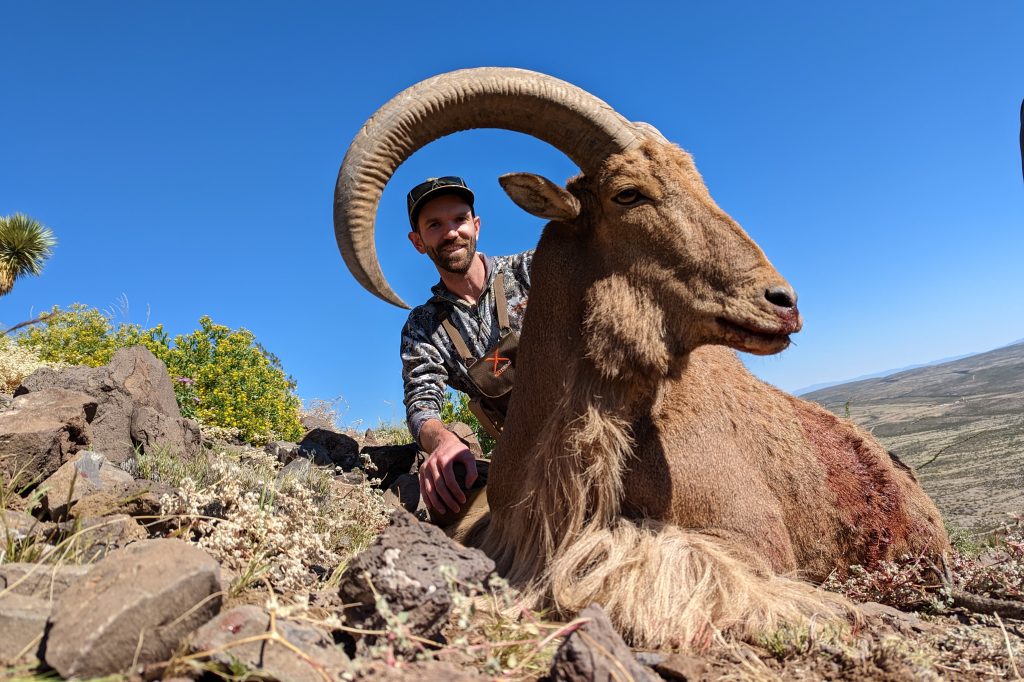
Ammo for Aoudad
Thanks to tough hide and hair, dense bones, and a never-say-die attitude Barbary sheep are challenging to kill. Always use a premium bullet and place your shot with precision.
In my opinion, Federal’s Terminal Ascent bullet is the best all-around hunting projectile currently on the market. It’s accurate, but what makes it really shine is the architecture of its design and construction. The rearward shank of the bullet is solid copper and will always penetrate aggressively. The front half of the bullet features a bonded lead core and Slipstream polymer tip to initiate rapid, controlled expansion. Ballistic Coefficient is very good, as is wind-bucking ability and retained downrange energy. The entire bullet is designed to give strong terminal performance at a wide range of impact velocities.
For my aoudad hunt, I selected a Kimber Mountain Ascent rifle topped with a Leupold VX-6 HD scope and chambered in .280 Ackley Improved. It’s one of my favorite rifles and is superbly lightweight–just right for sheep hunting. Muzzle velocity with 155-grain factory Terminal Ascent ammo is 2,937 feet per second.
My hunting partner, Jake, used the same caliber and ammunition in his hunting rifle. In the end, the final moments of our hunt proved how critical to success this choice would be for both of us. Both shot opportunities were fleeting and demanded rapid execution of an accurate shot. My ram was quartered away at impact; my bullet entered mid ribcage, ranged forward through heart, lungs, off-side ribs, and shoulder muscle and bone, coming to rest under the hide at the point of the far shoulder. Terminal performance on both sheep was spectacular, the spent bullets showing perfect upset.—A.vB.
